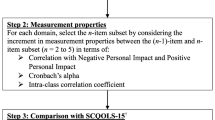Abstract
The present study investigates the validity, reliability, and applicability of the German version of the QUALIDEM, which is used to measure the quality of life of people with dementia in nursing homes. The sample consists of data from 203 people (average age 84 ± 9 years, 74% female) with mild to moderate dementia and 283 persons (average age 86 ± 8 years, 79% female) with severe to very severe dementia. These are baseline data from two lighthouse projects on dementia (STI-D and InDemA). The investigation of the feasibility is based on four expert interviews. The construct validity of the 37-item version of the QUALIDEM shown by the factors satisfied behavior, unapproachable and unsatisfied behavior, positive self-image, negative affect, social relations, feeling at home, restless tense behavior, and having something to do were identified. Furthermore, for the 18-item version the following four factors were computed: satisfied behavior, unapproachable and unsatisfied behavior, restless tense behavior, and negative affect. Cronbach’s α values for the determined factors are between 0.64 and 0.87 (37-item version) and between 0.61 and 0.83 (18-item version), which corresponds with a medium to high reliability (internal consistency). Furthermore, the student assistants assessed the QUALIDEM as applicable and practical.
Zusammenfassung
Die vorliegende Arbeit untersucht die Validität, Reliabilität und Anwendbarkeit der deutschsprachigen Version des QUALIDEM, mit dessen Hilfe die Lebensqualität von Menschen mit Demenz in der stationären Altenpflege erfasst werden kann. Die Stichprobe besteht aus Daten von 203 Menschen (mittleres Alter 84 ± 9 Jahre, 74% weiblich) mit einer leichten bis mittleren Demenz und 283 Personen (mittleres Alter 86 ± 8 Jahre, 79% weiblich) mit einer schweren bis sehr schweren Demenz. Grundlage sind die Basisdaten aus zwei Leuchtturmprojekten Demenz (STI-D und InDemA). Zur Untersuchung der Anwendbarkeit erfolgten vier Experteninterviews. Die Konstruktvalidität der 37-Item-Version des QUALIDEM zeigt sich anhand der Faktoren zufriedenes Verhalten, unzugängliches und unzufriedenes Verhalten, positive Selbstwahrnehmung, negativer Affekt, soziale Beziehungen, sich zu Hause fühlen, ruheloses, angespanntes Verhalten und etwas zu tun haben. Daneben konnten für die 18-Item-Version die Faktoren zufriedenes Verhalten, unzugängliches und unzufriedenes Verhalten, ruheloses, angespanntes Verhalten und negativer Affekt berechnet werden. Die Cronbachs α-Werte für die ermittelten Faktoren liegen zwischen 0,64 und 0,87 (37-Item-Version) sowie zwischen 0,61 und 0,83 (18-Item-Version) und entsprechen somit einer mittleren bis hohen internen Konsistenz als Reliabilität. Ferner wurde das QUALIDEM von den Ratern als anwendbar und praktikabel eingeschätzt.


Similar content being viewed by others
References
Aiken LH, Buchan J, Sochalski J et al (2004) Trends in international nurse migration. Health Aff (Millwood) 23:69–77
Bartholomeyczik S, Hardenacke D, Bureick G et al (2010) Interdisziplinäre Implementierung von Qualitätsinstrumenten zur Versorgung von Menschen mit Demenz in Altenheimen (InDemA). Z Gerontol Geriatr 43:71
Bouman IEA, Ettema TP, Wetzels RB et al (2010) Evaluation of Qualidem: a dementia-specific quality of life instrument for persons with dementia in residential settings; scalability and reliability of subscales in four Dutch field surveys. Int J Geriatr Psychiatry 26:711–722
Brod M, Stewart AL, Sands L et al (1999) Conceptualization and measurement of quality of life in dementia: the dementia quality of life instrument (DQoL). Gerontologist 39:25–35
Dichter M, Halek M, Bartholomeyczik S (2009) Measuring psycho-social aspects of people suffering from dementia in nursing homes with Quality of Life (QoL) Instruments. In: Alzheimer Europe Conference – Brussels. Brussels, Belgium
Ettema TP (2007) The development of a dementia specific Quality of Life scale: the first phase of construction. In: Ettema PT (ed) The construction of a dementia-specific Quality of Life instrument rated by professional caregivers: The QUALIDEM. Vrije Universiteit Amsterdam, Amsterdam, p 51–62
Ettema TP, Dröes R-M, De Lange J et al (2007) QUALIDEM: Development and evaluation of a dementia specific Quality of Life instrument. Scalability, reliability and internal structure. Int J Geriatr Psychiatry 22:549–556
Ettema TP, Dröes R-M, De Lange J et al (2005) A review of quality of life instruments used in dementia. Qual Life Res 14:675–686
Ettema TP, Dröes R-M, De Lange J et al (2005) The concept of quality of life in dementia in the different stages of the disease. Int Psychogeriatr 17:353–370
Ferri CP, Prince M, Brayne C et al (2005) Global prevalence of dementia: a Delphi consensus study. Lancet 366:2112–2117
Field A (2009) Discovering Statistics using SPSS. SAGE Publications Ltd, London
Folstein MF, Folstein SE, Mchugh PR (1975) Mini-mental state. A practical method for grading the cognitive state of patients for the clinician. J Psychiatr Res 12:189–198
Harris P, Sterin G (1999) Insider’s perspective: defining and preserving the self of dementia. J Ment Health Aging 5:241–256
Kaiser HF (1974) An index of factorial simplicity. Psychometrika 39:31–36
Kane RA, Kling KC, Bershadsky B et al (2003) Quality of life measures for nursing home residents. J Gerontol Med Sci 58:M240–M248
Moyle W, Mcallister M, Venturato L et al (2008) Quality of life and dementia. Dementia 6:175–191
Nordheim J, Liebich M (2010) Demenz und Herausforderndes Verhalten: Ergebnisse einer Studie zum strukturierten Pflegekonzept “Serial Trial Intervention” (STI-D). Z Gerontol Geriatr 43:70–71
Ready RE, Ott BR (2003) Quality of Life measures for dementia. Health Qual Life Outcomes 1:1–9
Reisberg B, Lauter H (1993) Clinical dementias staging methodologies. The International Psychogeriatric Association Newsletter 10:16–17
Smith SC, Lamping DL, Banerjee S et al (2005) Measurement of health-related quality of life for people with dementia: development of a new instrument (DEMQOL) and an evaluation of current methodology. Health Technol Assess NHS R&D HTA Programme 9:1–110
Conflict of interest
The corresponding author states that there are no conflicts of interest.
Acknowledgment
For the providing of data, we would like to thank the two teams of the STI-D und InDemA project. We also thank the student raters for their willingness to participate in the expert interviews.
Author information
Authors and Affiliations
Corresponding author
Rights and permissions
About this article
Cite this article
Dichter, M., Bartholomeyczik, S., Nordheim, J. et al. Validity, reliability, and feasibility of a quality of life questionnaire for people with dementia. Z Gerontol Geriat 44, 405–410 (2011). https://doi.org/10.1007/s00391-011-0235-9
Published:
Issue Date:
DOI: https://doi.org/10.1007/s00391-011-0235-9



